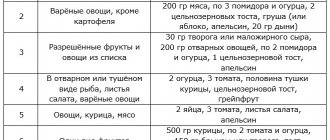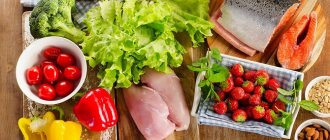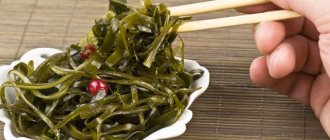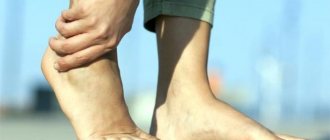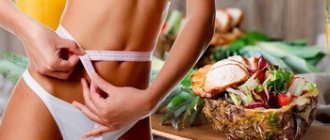Basic Rules
The goal of dietary nutrition for duodenitis is to achieve maximum chemical, mechanical and thermal gentle functioning of the digestive tract, and reduce the inflammatory process in the duodenum.
A diet for duodenitis involves limiting carbohydrates in the diet, but remains physiologically complete. According to the classification of treatment tables according to Pevzner, it corresponds to table No. 5. By order of the Ministry of Health of the Russian Federation No. 330, the prescription of a gentle diet (SB) is indicated.
Daily nutrient content:
- proteins – 85-90g, of which 60-70% are proteins of animal origin;
- fats – 70-80g, of which up to 20% are fats of vegetable origin;
- carbohydrates – 300-350g.
The energy value of the diet is 2170-2480 Kcal.
Basic principles of the treatment table for duodenitis:
- diet; Meals should be fractional, up to 5-6 times a day, at the same hours. Frequent meals in small portions can reduce inflammation by reducing the production of gastric juice and pancreatic juices that irritate the duodenum, as well as normalize the entire functioning of the gastrointestinal tract.
- temperature regime; Food should not be cold or hot (15-60°C), which ensures a gentle thermal effect.
- culinary processing; Dishes should be served pureed, boiled or steamed. Only liquid and mushy foods are allowed.
- salt; Salt in medical nutrition is somewhat limited (up to 8g per day): sodium chloride increases the secretion of gastric juice, which irritates the inflamed intestine.
- alcohol and smoking; During the period of exacerbation of chronic duodenitis or acute duodenitis, there is a categorical ban on alcoholic beverages. Ethanol stimulates gastric secretion and also slows down the regeneration of the duodenal mucosa. In addition, patients should stop smoking.
- chewing food; It is necessary to chew food thoroughly: this increases its mechanical processing and accelerates the onset of satiety. When eating, you should take moderation and not overeat, since the inflamed duodenum will not be able to ensure normal processes of breaking down food, which will aggravate the symptoms of duodenitis.
- product selection; It is necessary to exclude from the diet all foods that have a stimulating effect on gastric secretion and irritate the organs of the gastrointestinal tract.
- composition of dishes; In therapeutic nutrition for duodenitis, simple but varied dishes with a minimum number of ingredients should prevail. Complex dishes linger in the stomach for a long time, which means they increase the secretion of hydrochloric acid.
Treatment
Treatment is carried out sequentially and includes the establishment of nutritional and physical activity and drug therapy. The method of treating gastroduodenitis is selected depending on the level of acidity. When Hp is detected, antibiotics cannot be avoided. Multivitamins, sedatives, antispasmodics, and mineral waters are also used. The doctor takes into account the peculiarities of the course of gastroduodenitis and the presence of other diseases of the digestive system.
NEARMEDIC offers comprehensive examination and effective treatment in comfortable conditions without queues and at reasonable prices. There are several branches located in Moscow and the cities of the Moscow region, so you can choose the closest and most convenient one. Our advantages:
- a full range of equipment for ultrasound, colonoscopy, gastroscopy with collection of biopsy material;
- own laboratory with reduced time for preparing tests due to lack of workload;
- gastroenterologists with experience in training in European clinics under a contract from NEARMEDIC, specialized education, scientific publications, candidate and doctoral degrees;
- availability of specialists in the field of pediatric gastroenterology;
- an integrated approach to treatment, selection of individual drug combinations according to research;
- comfortable environment - choose a doctor, day and time of appointment, find out test results by phone, call a doctor for a consultation or a laboratory assistant to take samples.
To make an initial appointment, simply call us or fill out the form on the website.
Prohibited Products
The list of prohibited foods for duodenitis includes those that irritate the mucous membrane of the stomach and duodenum, so pickles, spicy dishes, and marinades are excluded due to their high content of purines, extractives, and organic acids.
In addition, it is necessary to abandon preservatives, stabilizers, and flavor enhancers: these chemical compounds also increase gastric secretion.
Products that contain coarse fiber linger in the stomach for a long time and adversely affect the course of duodenitis. It is not recommended to consume products that increase gas formation, have a negative effect on the digestive organs, and refractory fats, which, enveloping the mucous membranes of the stomach and duodenum, interfere with the absorption of nutrients.
The list of prohibited products includes:
- rye and fresh bread, baked goods made from yeast and puff pastry;
- meat, fish and mushroom broths;
- rich vegetable soups (cabbage soup, borscht, rassolnik, okroshka);
- fatty, stringy and “old” meat;
- fatty poultry (duck, goose, chicken skin);
- fatty fish;
- canned fish and meat;
- pickles, marinades;
- smoked meats;
- seasonings and spices (pepper, mustard, horseradish);
- legumes;
- pasta;
- white cabbage, radish, radish, daikon, turnip, sorrel, rutabaga;
- millet, pearl barley, barley cereals;
- sausages;
- fast food;
- sweet carbonated drinks, coffee, cocoa;
- fermented milk products (high-fat cottage cheese, sour cream);
- ice cream;
- alcohol;
- honey, candy, sugar, chocolate;
- cakes, butter creams;
- raw fruits.
Symptoms of the disease
An exacerbation of gastroduodenitis can occur unexpectedly in the form of an attack, when on an empty stomach after sleep, pain is felt in the upper abdomen (an attack and then relaxation, as during contractions), accompanied by nausea and vomiting. Chronic gastroduodenitis is manifested by regular aching pain, heartburn, and frequent vomiting. Symptoms may differ between children and adults.
The clinical picture depends on the stage of the disease - exacerbation or remission. The acute stage is characterized by intense pain, which can last up to two weeks; during remission, the patient does not feel any problems with digestion, but damage is visible on endoscopic examination. There is also an intermediate state - incomplete remission, when there is no pain, but the person continues to be bothered by bloating, heartburn, and heaviness.
The reasons for assuming a diagnosis after examination are weight loss, pallor of the skin, coating on the tongue and pain on palpation. Additionally, you can check yourself by examining the inner surface of your cheeks - dents from your teeth will be visible on it. The child experiences more symptoms and finds it difficult to tolerate them, which results in emotional suffering.
In general, the clinical picture for acute and chronic gastroduodenitis looks similar to the picture for a duodenal ulcer - the same three main syndromes are observed. Let's take a closer look at them.
Pain syndrome occurs during exacerbation and with chronic gastroduodenitis. The localization of pain depends on age - in adults it is observed in the area of the stomach and intestines, in children where the solar plexus is located or near the navel. Pain associated with periods of nutrition can be divided into 3 types:
- night pains - occur 4-5 hours after dinner, during sleep (if you eat, they will disappear);
- hunger pains - a person wakes up with them, but relief comes after breakfast;
- late pain - occurs when a lump processed in the stomach passes into the duodenum, which occurs after 1-3 hours.
What kind of pain the patient feels depends on the location of the inflammation - late pain is observed in patients localized in the stomach, at night and hungry in patients localized in the intestines. Late pain is difficult to deal with, but patients with localization in the intestines are “lucky”; they can relieve the symptom simply by eating. In addition to nutrition, pain can be caused by overexertion or stress.
Dyspeptic syndrome occurs due to the fact that food remains in the stomach for a long time (the muscles of the intestines and stomach do not work correctly) and enters the intestines at the wrong time. This syndrome includes heartburn, belching, nausea and vomiting, diarrhea + constipation in turn, heaviness, bloating, bitterness. Children, and sometimes adults, experience slipping syndrome, when the child goes to the toilet immediately after eating. If a child has high acidity, he or she will experience a symptom such as sweating.
And the last group of symptoms is collected in the category of asthenovegetative syndrome, which includes weakness, fatigue, lethargy, rare pulse, low blood pressure.
Authorized Products
The list of permitted products for duodenitis includes those that do not activate the production of hydrochloric acid in the stomach, but, on the contrary, neutralize it. The diet for this disease includes food that provides mechanical sparing of the gastrointestinal tract: as ready as possible for breakdown in the digestive tract (mashed, rolled or boiled to a puree state).
In addition, the treatment table must necessarily contain foods and drinks with a high content of ascorbic acid. Vitamin C accelerates the regeneration of the inflamed duodenal mucosa and also strengthens the immune system.
In case of severe exacerbation of duodenitis, such a diet should be followed for 7-10 days.
The list of recommended products includes:
- white bread yesterday or dried, dry cookies, dry biscuit;
- vegetable or cereal soups (with boiled cereals), milk and puree soups from vegetables (for dressing - butter, egg-milk mixture, cream in a small amount);
- lean meat (lean beef, veal, lamb, rabbit) in the form of steam cutlets, soufflé, meatballs;
- potato, carrot and beet side dishes, boiled cauliflower;
- puddings and porridges boiled from semolina, rice, buckwheat, oatmeal;
- small pasta (vermicelli);
- steamed egg white omelette, soft-boiled eggs;
- low-fat milk, condensed milk, cream, non-acidic yogurt and kefir, pureed non-sour cottage cheese, low-fat and mild varieties of cheese;
- boiled and pureed fruits and berries, mousses, jellies and compotes made from them;
- weak tea diluted with milk, juices from fruits and berries diluted with water, rose hip decoction;
- butter, vegetable oils;
- salads of boiled vegetables, seasoned with vegetable oil.
Causes
There are internal and external causes of chronic gastroduodenitis. External ones include:
- H. pylori infection. This is a spiral-shaped bacterium that can survive in the hydrochloric acid of the stomach. Helicobacter pylori infection is the main cause of inflammatory diseases of the stomach - gastritis, gastroduodenitis and peptic ulcers. Infection is also considered as a factor in the development of gastric cancer.
- Errors in nutrition. Food must be well chewed so that it enters the stomach in a mushy form. Large, rough bolus of food irritate the stomach lining, promoting inflammation. In addition, addiction to too spicy, hot or cold foods also increases the risk of inflammatory pathologies of the digestive tract.
- Excessive consumption of alcoholic beverages or strong coffee. Alcohol has an irritating effect on the mucous membrane, and coffee (especially drunk on an empty stomach) stimulates the production of hydrochloric acid.
- The action of certain chemicals. These include pesticides, acids, alkalis, heavy metals and others.
- Taking certain medications. Most often these are non-steroidal anti-inflammatory drugs (they cannot be taken for more than 3-5 days in a row) and antibiotics.
- Smoking. Smokers experience vascular spasm (including in the digestive tract), which contributes to the appearance of inflammation.
Internal causes of chronic gastroduodenitis:
- diseases of the liver and biliary tract;
- diseases of the endocrine system;
- inflammation of the pancreas (pancreatitis);
- cardiovascular and pulmonary diseases in which hypoxia is observed (oxygen starvation of tissues);
- hereditary predisposition;
- allergic and autoimmune diseases;
- renal failure, in which large amounts of toxic nitrogenous substances are released through the intestinal mucosa;
- disruption of mucus production in the stomach.
Stress and gastritis
It became known relatively recently that the lion's share of cases of gastritis occurs due to infection.
Barry Marshall and Robin Warren are scientists who have proven that gastritis and ulcers of the stomach and duodenum occur against the background of Helicobacter pylori infection. In 2005 they received the Nobel Prize for their discovery. Before this discovery, other theories regarding these diseases dominated the world. In particular, it was believed that the main cause of inflammatory pathologies of the stomach is stress. Stress can indeed be a factor that increases the symptoms of the disease. However, in a healthy person, stress cannot cause gastroduodenitis.
The need to follow a diet
Compliance with therapeutic nutrition for duodenitis can relieve unpleasant symptoms during an acute process or exacerbation (pain, nausea, vomiting). In addition, proper nutrition during the period of remission allows you to delay the exacerbation of the disease.
A diet for duodenitis refers to proper and healthy food, normalizes the functioning of the entire digestive tract, prevents complications, and also disciplines the patient. In addition, the principles of a healthy diet have a beneficial effect on the patient’s well-being and appearance.
What it is
Gastroduodenitis is an inflammation of the pyloric part of the stomach (the part that goes into the intestines) and duodenum.
In other words, it is a combination of gastritis and duodenitis. This disease is more severe than the pathologists mentioned separately. Accordingly, gastroduodenitis is less treatable. If the form of the disease is chronic, periods of remission (subsidence) are replaced by exacerbations. Chronic gastroduodenitis is characterized by a gradual loss of regenerative functions by cells. Over time, they die off, which leads to disruption of the secretory, motor and evacuation functions of the pyloric part of the stomach and duodenum¹.
There are no exact statistics regarding chronic gastroduodenitis. According to some sources, up to 30% of people suffer from the disease². Moreover, the pathology is often found among children - often inflammatory processes in the stomach and duodenum begin in childhood and adolescence. As a rule, the bacterium Helicobacter pylori is to blame.
Inflammation usually begins in the stomach and spreads lower into the duodenal tissue. Over time, metaplasia develops - the replacement of some functional cells of the mucous membrane with others. Then the already changed parts of the duodenal tissue are exposed to the acidic contents of the stomach (with gastroduodenitis, the acidity of the stomach usually increases), which only aggravates the inflammatory process.
Figure 1. Gastritis and gastroduodenitis. Image: Olek Remesz (wiki-pl: Orem, commons: Orem) / Wikipedia (CC BY-SA 2.5)
Diet for gastroduodenitis - table No. 5
This diet is a transitional stage from strict restrictions to general nutrition. The dishes remain boiled and baked, but are no longer pureed. The patient should also eat small and often (at least 5 times a day), chewing food thoroughly.
The diet is expanded by the introduction of tomato juice, weak coffee with milk, rye bread, milk sausages, herbs, ripe fresh tomatoes, canned green peas, sour sauerkraut, soaked herring, lemon and jam.
Prevention
Prevention of gastroduodenitis has two directions - preventing exacerbations of chronic gastroduodenitis and preventing the development of pathology. The set of preventive measures includes:
- healthy lifestyle;
- eliminating bad habits;
- moderate physical activity;
- alcohol restriction;
- maintaining a daily routine - sleep, rest and work;
- taking vitamins;
- strengthening the immune system;
- timely treatment of infectious diseases of the gastrointestinal tract.
Diagnostics
Diagnosis of gastroduodenitis can take place in two directions:
- endoscopy – determines the degree of damage and the condition of the mucous membranes;
- histology - determines the relevance of inflammation of the mucous membranes, shows the presence of atrophy and the degree of its development.
The following additional survey measures are used:
- fluoroscopy;
- pH-metry using a special probe;
- Ultrasound gives a general idea.
During the diagnostic process, it is extremely important to determine the type and form of the disease, which are the determining factor in choosing a treatment method.



